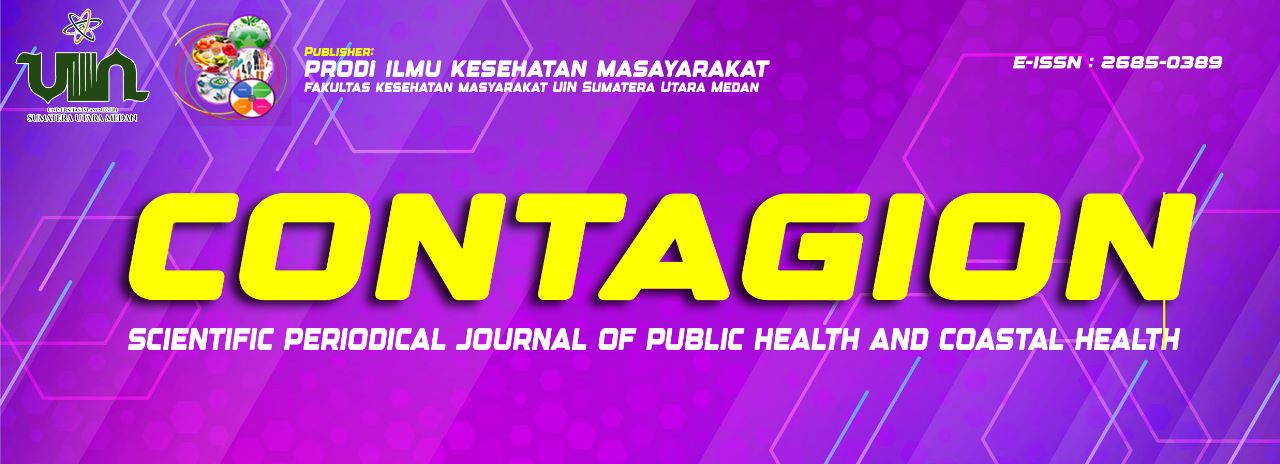The Influence of Nutritional Status on the Incidence of Postpartum Hemorrhage in Three Community Health Centers (CHCs) in Dili, Timor Leste
Abstract
Postpartum hemorrhage (PPH) remains a leading cause of maternal mortality in low- and middle-income countries, including Timor-Leste. This analytical cross-sectional study, conducted from January to December 2024 in three community health centers (CHCs) in Dili, examined the association between maternal nutritional status and the incidence of PPH. Nutritional indicators included pre-pregnancy body mass index (BMI), gestational weight gain, anemia status, and mid-upper arm circumference (MUAC). Data were collected from medical records of 130 postpartum mothers (65 with PPH, 65 without). The prevalence of PPH was 50%. Among participants, 22.1% had anemia (hemoglobin <11 g/dL), 50.8% had MUAC <23.5 cm, and 41.5% had a pre-pregnancy BMI outside the WHO normal range (18.5–24.9 kg/m²). Only 26.4% achieved gestational weight gain within Institute of Medicine guidelines. Logistic regression analysis revealed that anemia significantly increased the risk of PPH (OR = 3.4; 95% CI: 1.38–8.40; p = 0.011), while other nutritional indicators showed no significant association. These findings highlight the critical role of antenatal anemia screening and targeted nutritional interventions in reducing PPH risk. This study provides locally relevant evidence to inform maternal health strategies in Timor-Leste.
Keywords: Postpartum hemorrhage, Pre-pregnancy BMI, weight gain, Mid-Upper Arm Circumference, Antenatal Care, Community health center
Full Text:
PDFReferences
Dewidar, O., John, J., Baqar, A., Madani, M. T., Saad, A., Riddle, A., Ota, E., Kung’u, J. K., Arabi, M., Raut, M. K., Klobodu, S. S., Rowe, S., Hatchard, J., Busch-Hallen, J., Jalal, C., Wuehler, S., & Welch, V. (2023). Effectiveness of nutrition counseling for pregnant women in low- and middle-income countries to improve maternal and infant behavioral, nutritional, and health outcomes: A systematic review. Campbell Systematic Reviews, 19(4). https://doi.org/10.1002/cl2.1361
Diana, S. A., Anita, N., & Nurfadilah, N. (2024). Association between maternal nutritional status assessed by mid-upper arm circumference (muac) and infant birth weight. Genius Journal, 5(1), 106–113. https://doi.org/10.56359/gj.v5i1.407
EIS CHC Becora. (2024). Estatistika Informasaun Saude (EIS) Becora.
EIS CHC Comoro. (2024). Estatistika Informasaun Saude (EIS) Comoro.
EIS Vera-Cruz. (2024). Estatistika Informasaun Saude (Eis) Vera-Cruz.
Faysal, H., Araji, T., & Ahmadzia, H. K. (2023). Recognizing who is at risk for postpartum hemorrhage: targeting anemic women and scoring systems for clinical use. American Journal of Obstetrics and Gynecology MFM, 5(2), 100745. https://doi.org/10.1016/j.ajogmf.2022.100745
Fernandes, A. P., Ariani, N., Wardani, D. S., Peguinho, H., Da Silva, Z. F., & Da Silva, J. F. L. (2025). Impact of socio-economic factors on postpartum haemorrhage in three health centres in dili, timor leste- cross-sectional study. Journal of Applied Nursing and Health, 7(2), 211–220. https://doi.org/10.55018/janh.v7i2.369
Garcia-Casal, M. N., Dary, O., Jefferds, M. E., & Pasricha, S. (2023). Diagnosing anemia: Challenges selecting methods, addressing underlying causes, and implementing actions at the public health level. Annals of the New York Academy of Sciences, 1524(1), 37–50. https://doi.org/10.1111/nyas.14996
González-Fernández, D., Muralidharan, O., Neves, P. A., & Bhutta, Z. A. (2024). Associations of maternal nutritional status and supplementation with fetal, newborn, and infant outcomes in low-income and middle-income settings: An Overview of Reviews. Nutrients, 16(21), 3725. https://doi.org/10.3390/nu16213725
Habonimana, D., & Batura, N. (2021). Empirical analysis of socio-economic determinants of maternal health services utilisation in Burundi. BMC Pregnancy and Childbirth, 21(1), 684. https://doi.org/10.1186/s12884-021-04162-0
Keya, T. A. (2023). Prevalence and predictors of anaemia among women of reproductive age in south and southeast asia. Cureus, 15(12). https://doi.org/10.7759/cureus.50090
Krsman, A., Stajić, D., Baturan, B., Stanković, M., Kupušinac, A., Kadić, U., Pantelić, M., Gvozdenović, L., Pop Trajković, S., Simić, D., Živadinović, A., & Živadinović, L. (2023). Correlation between increased maternal body mass index and pregnancy complications. European Review for Medical and Pharmacological Sciences, 27(8), 3508–3513. https://doi.org/10.26355/eurrev_202304_32123
Lakew, G., Yirsaw, A. N., Berhie, A. Y., Belayneh, A. G., Bogale, S. K., Getachew, E., Andarge, G. A., Seid, K., & Bogale, E. K. (2024). Correction: Prevalence and associated factors of anemia among postpartum mothers in public health facilities in Ethiopia, 2024: a systematic review and meta-analysis. BMC Pregnancy and Childbirth, 24(1), 571. https://doi.org/10.1186/s12884-024-06781-9
Shenoy, S., Sharma, P., Rao, A., Aparna, N., Adenikinju, D., Iloegbu, C., Pateña, J., Vieira, D., Gyamfi, J., & Peprah, E. (2023). Evidence-based interventions to reduce maternal malnutrition in low and middle-income countries: a systematic review. Frontiers in Health Services, 3(October), 1–11. https://doi.org/10.3389/frhs.2023.1155928
Timor-Leste Ministry of Health. (2022). National Health Sector Nutrition Strategic Plan 2022-2026. In Ministry of Health, Timor-Leste. https://www.unicef.org/timorleste/reports/national-health-sector-nutrition-strategic-plan
Timor-Leste National Institute of Statistics (INETL). (2024). Population and Housing Census Timor-Leste 2022, Thematic report – Mortality. https://inetl-ip.gov.tl/2024/05/14/census-2022-thematic-report-mortality/
Wang, D., Nguyen, C. H., Asghari-Kamrani, A., Partap, U., Shah, I., & Fawzi, W. W. (2025). Nutrition and reproductive potential of women in low- and middle-income countries: a systematic review and meta-analysis. BMJ Global Health, 10(Suppl 1), e015713. https://doi.org/10.1136/bmjgh-2024-015713
Wang, M., & Ren, M. (2025). World Health Day 2025: Time to change mindset beyond global commitment to maternal health and women’s well-being. China CDC Weekly, 7(14), 449–452. https://doi.org/10.46234/ccdcw2025.074
Williams, C. R., Adnet, G., Gallos, I. D., Coomarasamy, A., Gülmezoglu, A. M., Islam, M. A., Rushwan, S., Widmer, M., Althabe, F., & Oladapo, O. T. (2024). Research agenda for ending preventable maternal deaths from postpartum haemorrhage: a WHO research prioritisation exercise. BMJ Global Health, 9(11), e015342. https://doi.org/10.1136/bmjgh-2024-015342
WOMAN-2 trial collaborators. Electronic address: woman2@lshtm.ac.uk, & WOMAN-2 trial collaborators. (2023). Maternal anaemia and the risk of postpartum haemorrhage: a cohort analysis of data from the WOMAN-2 trial. The Lancet. Global Health, 11(8), e1249–e1259. https://doi.org/10.1016/S2214-109X(23)00245-0
World Health Organization. (2023). A Roadmap To Combat Postpartum Haemorrhage Between 2023 And 2030. In World Health Organisation Geneva, Switzerland. https://www.who.int/publications/i/item/9789240081802
World Health Organization. (2025a). Anaemia. World Health Organization. https://www.who.int/news-room/fact-sheets/detail/anaemia
World Health Organization. (2025b). Global anaemia estimates in women and children: 2025 Edition. The Global Health Observatory (GHO), World Health Organization. https://www.who.int/data/gho/data/themes/topics/anaemia_in_women_and_children
Young, M. F., Luo, H., & Suchdev, P. S. (2023). The challenge of defining the global burden of iron deficiency anaemia. In The Lancet Haematology (Vol. 10, Issue 9, pp. e702–e704). https://doi.org/10.1016/S2352-3026(23)00168-0
DOI: http://dx.doi.org/10.30829/contagion.v7i2.24975
Refbacks
- There are currently no refbacks.
Copyright (c) 2025 Alcinda Pinto Fernandes

This work is licensed under a Creative Commons Attribution-ShareAlike 4.0 International License.






